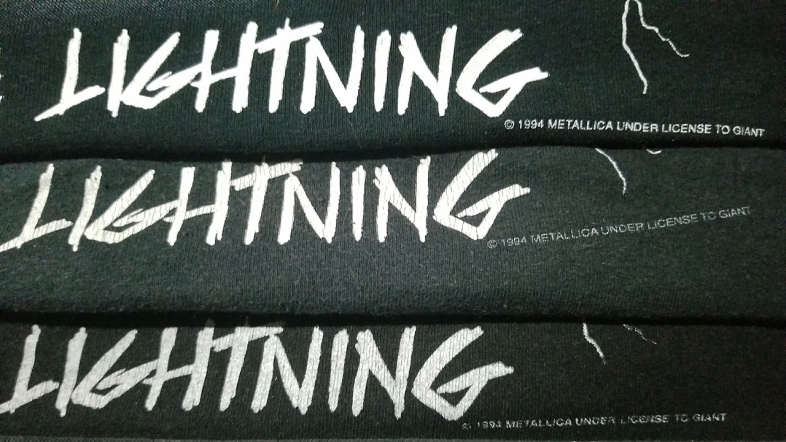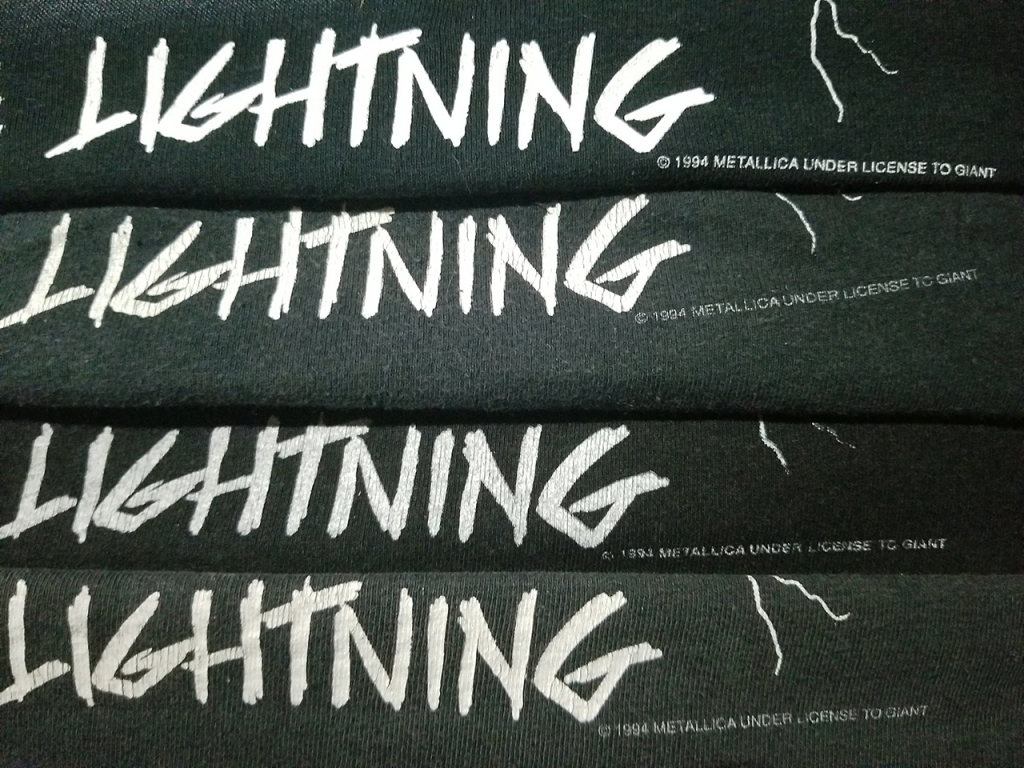Can Copyright Lines Be Used To Authenticate and Date a T-Shirt?

Copyright lines, that tiny text that often appears near the edge of the print on a t-shirt, is another tool in your vintage t-shirt authentication toolbox. But just like single-stitching, it comes with plenty of exceptions that make it unreliable as a stand-alone signal of age and authenticity.
Does the copyright date indicate when the t-shirt was printed?
It can, but the copyright date you see on your t-shirt is the date the copyright on the design was completed or registered. Which is not necessarily the date the shirt was printed. There are no requirements to update a copyright every year, or at all.
Let’s examine some Metallica ‘Ride the Lightning’ tees. The majority of the ones floating around have a 1994 copyright date (despite the original versions being from the 1980s.) This shirt continued to be printed with a 1994 copyright into the 2000s, maybe even longer. Of the four I have, only one of them has a Giant tag, but it features Giant’s URL on it, so it certainly isn’t 1994. The other three are likely from the aughts.

This page contains a form, you can see it here
Remember, merchandisers, are well aware that nostalgia sells, so it also plays to their favor to have an old date on modern print, so don’t get duped.
If a shirt doesn’t have a copyright, is it fake?
No. Maybe. Sometimes.
T-shirts don’t always have copyright dates and are still 100% vintage. But we should also get into the bootleg discussion here. A lot of bootlegs that are 20+ years old are actually original, uncopyrighted designs that aren’t licensed.
But if we’re discussing a modern counterfeiter attempting to knock off a vintage print, why would they go through all the trouble of copying a print, and then leave out what is likely the easiest part of the print to duplicate? They clearly are not afraid of copyright infringement.
To make matters more confusing, companies like Giant didn’t always include a copyright line.
If a shirt does have a copyright, is it authentic?
No. Maybe. Sometimes.
Bootleggers usually copy every detail on the shirt as best they can, so the presence of a copyright line doesn’t make it authentic.
While authenticating you should examine the copyright line and compare it with known originals. Bootleggers will often get lazy and use a slightly different font, slightly larger font, or get the placement wrong. And because copyright lines are so small, often fade, or if a bootlegger is attempting to copy it from photos on the internet, you can bet it’s often inaccurate.
To make matters more confusing, the copyright doesn’t always match the t-shirt tag. Giant for example didn’t manufacture their own shirts and didn’t always have their tag sewn into the blank they were using.
If a shirt has a fuzzy copyright line, is it fake?
“The copyright is fuzzy! It’s fake!,” is a claim I’ve heard made several times. Please remember this can and does happen during the original screen printing process – there can be an ink mishap. Remember, this is a very fine detail to print. That said, it can happen during the forgery process too. So it’s not a great way to make a determination as to authenticity. Focus on the font more than the fuzziness.
What do multiple copyright dates mean?
Multiple copyright dates indicate an update to an existing copyright. A t-shirt that lists more than one date is detailing the dates the copyright holder updated the work. It will typically list the initial copyright date and the dates of the subsequent revisions.
Schulz/Peanuts-related t-shirts are a great example of this. Charlie Brown is the OG Peanuts character and was the first to get a copyright in 1950. And you’ll often notice any shirts with him printed from the 1950s to 1994 will often say 1950.
As time wore on the Peanuts gang grew. Snoopy was introduced in 1958, got an update in 1965. And then along came Snoopy’s alter ego sunglass-wearing, college-attending, “Joe Cool” as well as Woodstock in 1970.
Because the most recent copyright date on the shirt is 1971, sellers will then often list a shirt as being from the 1970s when it is likely to be from the 1980s or later.
What Do Screen Printers Say?
“When we created a design, we would put the copyright on it. After that, the copyright was rarely ever updated – not necessarily because nostalgia sells, but because it would be a giant pain to go through all the designs and update the copyright year after year. It would only really be updated upon request, or if we were taking over the design from another company that had their copyright on it.” B. Weiss, a former Wild Oats employee told us.
Band Tees Printed in the 2000s
“But then in the early 2000’s something weird happened. Bands started bitching if their shirt had a copyright on it because it wasn’t ‘punk’ or ‘metal’ to have it. They bitched so much that we just started dropping the copyright from all tees unless it was specifically requested by the client. That makes it really hard to determine when your band tee is from unless it had a tour back. But of course, that doesn’t always work either, as sometimes the old backs get reprinted as well.”
Summary of Copyrights on Vintage T-Shirts
- The copyright indicates the date the work was copyrighted, not the date it was printed, although the two can coincide.
- There is no requirement to update a copyright, so remember an old copyright date can be used on modern tees.
- The lack of a copyright date on a t-shirt doesn’t necessarily disqualify it from being authentic or vintage.
- The presence of a copyright date on a t-shirt, even if that date is 20+ years old, doesn’t necessarily mean the shirt is vintage.
- More reliably, assess the copyright as part of the print while you’re comparing it with a known original.
- Use multiple factors to determine your tee’s age and authenticity rather than taking copyright date’s word for it.
- Check out our complete guide to performing a legit check on a vintage tee.
This page contains a form, you can see it here